SQL SERVER
SQL SERVER TRAINING
SQL SERVER TRAINING: V CUBE SOFTWARE SOLUTIONS provides SQL Server Training in Hyderabad. We offer Real-time Database Design with hands-on experience in live Case Studies.
SQL server Training in Kukatpally Duration:25 days

Best SQL Training in Hyderabad
Curriculum for the SQL SERVER
About Database & Data Warehouse
- What is Database?
- What is a Data Warehouse?
- Difference between Database & Data Warehouse
SQL Server 2012/2014 Database Design
- Database Creation using GUI
- Database Creation using T-SQL Scripts
- DB Design using Files • File locations and Size Parameters
- DB Log Files, Growth and Placement
- DB Structure Modifications & Ownership
SQL Server Tables and T-SQL Queries
- Table creation using T-SQL Scripts
- DML Operations: INSERT, UPDATE, DELETE
- Single Row and Multi-Row Insert Statements
- Table Aliases, Column Aliases & Usage
- Table creation with Schemas
- DELETE versus TRUNCATE Statements
- SELECT Queries and Sub Queries
- Schemas and Nested Queries with Aliases
Constraints, Keys, and Data Validation
- Data Integrity and Normal Forms
- Tables with Keys & Constraints
- NULL and IDENTITY Properties – Usage
- UNIQUE KEY Constraint and NOT NULL
- PRIMARY KEY Constraint & Importance
- FOREIGN KEY and REFERENCE Attributes
- CHECK and DEFAULT Constraints, Usage
Joins, Sub Queries, and Nested Queries
- SELECT Statements – IIF, SWITCH, CHOOSE
- ORDER BY, GROUP BY, GROUPING, HAVING
- Sub Queries, Nested Queries and EXISTS
- DELETE from SELECT, UPDATE from SELECT
- INSERT INTO … SELECT & Data Copy
- Inner Joins – Purpose and Performance
- Outer Joins – Types, Advantages, and Usage
- Cross Joins – Advantages and Limitations
- Self Joins and Sub Queries
Joins, Views, and Nested Queries
- Benefits of Views – End User Access
- Defining Views on Tables and Views
- SCHEMABINDING and Encryption Options
- ALTER TABLE Issues and Solutions with Views
- System Views & Management Views: Audits
- Joins and Nested Sub Queries in Views
User Defined Functions and Joins
- Functions – Syntax, Usage, and Importance
- Scalar-Valued Functions and Examples
- Table Valued Functions and Examples
- System Functions and Joins – CROSS APPLY
- Date, Time and Conversion Functions
- String Functions and Meta-data Functions
- ROWCOUNT, GROUPING, ROLLUP Functions
- Joining Functions and Tables / Views
Indexes and Query Tuning
- Need for Indexes, Index Types & Usage
- Indexing Table & View Columns
- Index SCAN AND SEEK
- PRIMARY KEYS and Non-Clustered Indexes
Stored Procedures and Benefits
- Need for Stored Procedures & Syntax
- Use of Variables and Query Parameters
- Stored Procedures with Loops &IF… ELSE
- SCHEMABINDING and ENCRYPTION Options
- INPUT, OUTPUT & RESULTSET Parameters
- System Stored Procedures and Nesting
- Dynamic SQL Queries and Parameters
- Stored Procedures, Data Validation Options
- OUTPUT Parameters and Result set Options
Triggers and Memory Limitations
- Triggers – Architecture, Types & Usage
- DML Triggers and Performance Impact
- INSERTED and DELETED Memory Tables
- Triggers for Audit Operations (Memory)
Cursors, Stored Procedures, CTE
- Cursor Declaration and Fetch Options
- STATIC and DYNAMIC Cursor Types
- SCROLL and FORWARD_ONLY Cursors
- LOCAL and GLOBAL Cursors – Scope
- KEYSET Cursors and Temp Objects
- Embedding Cursors in SPs and Functions
- Temp Tables and Procedures with Cursors
- Common Table Expressions (CTE) and Queries
- Stored Procedures with CTE: Tuning Options
Transactions & Procedures
- Transaction Options and Stored Procedures
- ACID Properties in T-SQL and Scope
- EXPLICIT Transaction Types and Issues
- IMPLICIT Transactions Types and Issues
- AUTOCOMMIT Transaction and Advantages
- Nested Points and Save Points usage
- Query Blocking Issues and Query Hints
- SPs with Transactions & Temp Objects
SQL Training And Placement in Hyderabad
Course's Key Highlights
100+ hours of learning
Real-time industry professionals curate the course.
Internships and live projects
A cutting-edge training facility
Dedicated staff of placement experts
Placement is guaranteed 100 percent Assistance
28+ Skills That Are Useful in the Workplace
Trainers with a minimum of 12 years of experience
Videos and back-up classes
Subject Matter Experts Deliver Guest Lectures
Description of the SQL Server Course Why SQL Server is so popular:
Best SQL Training Institutes in Hyderabad
SQL Server is a Microsoft product. It used to manage and store information. SQL Server is a “relational database management system”. Apart, this term means two things. First, that data stored inside SQL Server in a “relational database”. second, that SQL Server is an entire “management system”, not a database. SQL itself stands for Structured Query Language. The language used to manage and administer the database server.
A Power BI dataset from a relational database that exists on premises in your local network. Specifically, this tutorial uses a sample SQL Server database, which Power BI must access through an on-premises data gateway.
1. Create and publish a Power BI Desktop (.pbix) file that imports data from a SQL Server database on-premises.
2. Configure Power BI’s data source and dataset settings for SQL Server connectivity via a data gateway.
3. Set up a refresh schedule to ensure that your Power BI dataset is always up to date.
4. Perform an on-demand dataset refresh.
5. Examine the refresh history to see how previous refresh cycles fared.
6. Delete the artefacts created in this tutorial to free up resources.
TOPS JOBS FOR SQL
Best Institute For SQL in Hyderabad
1).Database Developer: Database developers ensure that DBMS’s are capable of handling massive amounts of data. Most database developers work with software development teams. This career requires extensive knowledge of SQL. Three distinct areas are common to the job of database developer:
- Modifying and editing databases
- New databases design and development
- Investigating database issues
The average salary for a Database Developer is $98,415 annually. Become Database Developer with Sql Server Training in KPHB
2)Software Developer :A software designer is responsible for both the design and development phases in software creation. He will plan out all the necessary parts of the automated tasks. To help illustrate the process, he plans documentation and flowcharts.
The average annual salary for a Software Developer is $102,528.
3)Software Consultant: Below are some of the Database solutions that Software Consultants can create:
Database Development Services
Database Administration and Maintenance Services
Troubleshooting MS SQL Database
Database-optimization and performance scalability
Database design using Data modeling tool like xCase
MS SQL Report Services – Custom Reports
SSIS SQL Server Integration Services
The annual average salary for a Software Consultant is $118,000.
4)Dot(.)
Data is rapidly becoming one of the most important parts of technological advancement..NET is no exception. .NET developers should be familiar with Microsoft’s own SQL databases and rising innovation, such as NoSQL.
The average annual salary for a .Net developer is $107 250
What is the Future of SQL SERVER
Best SQL Coaching in Hyderabad
SQL will be around until the end of time. Relational databases systems are still important, even with Big Data Systems’ rise. RDBMS companies are also introducing Big Data-flavored features such as scaling, distributed processing, and data warehousing in order to manage large amounts of structured data using the existing implementations. SQL is a good place to begin and has great potential. However, you should improve your skills and expand your scope to meet different needs. These are some things you need to keep in mind.
- Start with a platform. SQL is an ANSI-standard database scripting language. However, it has been modified by large technology companies like Microsoft, Oracle and IBM. Learn SQL on a platform you have purchased. If it’s Microsoft, install SQL Server to explore T-SQL. While general statements are universal across all platforms, you will find that there are changes in query, datatypes and execution levels as you dig deeper.
- Explore the database engine to learn more about this product. You will be able to write better queries if you know how the queries are evaluated within the server.
- Learn how to manage databases.
- Knowledge of data integration and reporting would be an advantage. If it’s SQL Server, then you can try SSIS (SQL Server Integration Services), and SSRS(SQL Server Reporting Services).
- HIVE is a last resort if you want to dive into Big Data. It’s similar to SQL
SQL is appearing in more and more places. The SQLite data is integrated into many modern web browsers like Google Chrome, Opera and Safari. It also integrates into many mobile operating systems, including Blackberry OS and Google Android.
On the other hand, the rapid growth in data and metadata means that optimization of Big Data SQL, such as SQL for Hadoop and cloud computing is not keeping up with it. The rapid intake of data and the demand for real time analysis a competitive advantage.
Even NoSQL databases (competitors to SQL) started to support SQL. Google taught its Spanner2.0 global-scale database SQL instead of a NoSQL implementation from Version 1.0. They see that SQL is so common that they don’t need to reinvent the wheel when they create their own query language. Google created “Standard SQL to be used across many Google apps like BigQuery, Adwords and so forth.
Data is being moved to the cloud more frequently, so it is possible to replicate it for fault tolerance and make it easier to query it. Apache Cassandra standards and freely-available tools such as Apache Hive mean that everyone can afford cloud-based data.
On the other hand, you can find SQL databases everywhere you look in web browsers or on mobile phones. You can also download the My SQL , Work Bench, My SQL community edition, and SQLite free of charge to create your apps and then deploy them to Heroku.
SQL is the “glue” that binds all data and tools together. It will continue to do so for many years.Now is the Best Time to Get SQL Server training in kukatpally and Upgrade your skills
Upskill & Reskill For Your Future With Our Software Courses
| Best SQL Server Training Institutes in Hyderabad |

Quick Links
- Home
- About Us
- Courses
- Contact Us
Other Pages
Contact Info
- 2nd Floor Above Raymond’s Clothing Store KPHB, Phase-1, Kukatpally, Hyderabad
- +91 7675070124, +91 9059456742
- contact@vcubegroup.com
